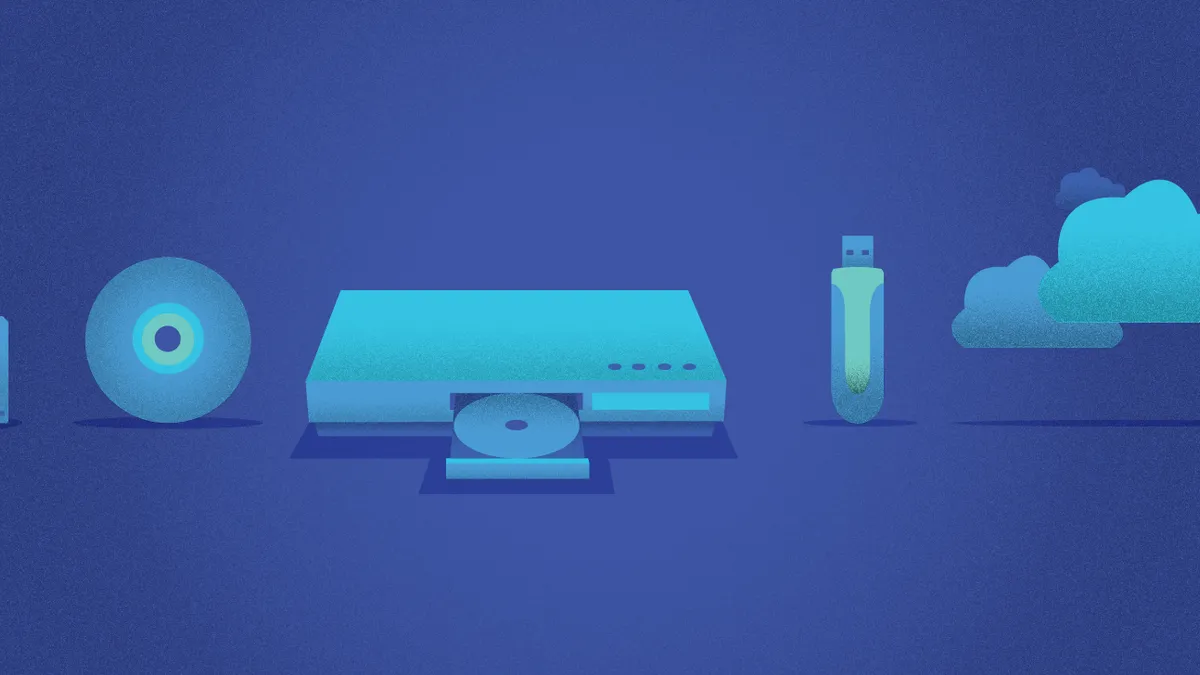Editor's note: This story is part of Throwback Thursday, an occasional series looking at the history of technology.
Magnetic tape was likely the bane of existence for anyone born prior to Y2K. In a fraction of a second, a beloved cassette tape could be unwound, tangled and reduce its victim to tears.
But magnetic tape is a part of the foundation of the cloud, albeit with a few modifications along the way.
Ultimately, the technological ecosystem adopts to the current storage practices. There is simply more data today than ever before. The same is true for tomorrow as about 2.5 quintillion bytes of data are created daily.
The growing pains associated with Big Data are issues companies like IBM take on. IBM became the "natural" pioneer of storage invention, Dr. Haris Pozidis, master inventor at IBM, told CIO Dive.
Magnetic principals laid the foundation for data storage in the 1950s when IBM created the first "incarnation of storage medium" for the enterprise, said Pozidis.
To complement the memory capabilities of magnetic tape but with the added benefit of mobility, IBM engineers created the floppy disk. Original floppy disks were built "bare" but modestly covered to reduce dirt built up.
Though hard disk drives hold the same magnetic principles of tape, personal data became portable, it allowed personal computers to access and interpret data. Still, floppy disks had the capacity of mere megabytes or even kilobytes, according to Pozidis.
By comparison, IBM engineers set the world record for harnessing 330 terabytes of data into a cartridge one could hold in their hands. For reference, that's equivalent to 330 million books, Pozidis said.
Floppy disks ultimately gave storage legs when magnetic tape initially couldn't. But a floppy disk had a literal size limit because its "storage density" was still unknown to IBM engineers, said Pozidis.
Enter optical storage
Emerging during the 1980s and 1990s were CDs and DVDs, or optical storage, which offered solutions for audio and visual content. Pozidis credits Phillips and Sony for the revolution of optical storage.
But the very content that inspired optical storage demanded broader capacity, thus resulting in more innovative lasers.
Lasers were the "main medium by which you can store and read information in an optical disk," said Pozidis. Beginning from infrared lasers for CDs, moving to red lasers for DVDs and finally blue lasers gave way for Blue-ray, which is the "current optical standard."
In the late 80s, wafer technology emerged to create chips and silicone, replacing magnetic optical methods. The chips were made in the same way processing chips are made for today's servers. Toshiba pioneered the use of silicone, with which a company can essentially print electronic servers; this gave way to silicon-based means of storage, or flash memory, said Pozidis.
As flash memory, or USB drives, flooded the consumer market, it also gave way to mobile devices, such as phones and cameras, "otherwise they would be like bricks." Essentially, flash was the solution for "miniaturization and mass storage," Pozidis said.
How to adapt to new storage
New means of storage almost always required a restructuring of the current technical infrastructure, and this is typically where resistance arises. The same is true for today.
Global enterprise storage system revenue reached $10.8 billion in Q2 2017, according to an IDC report. The sales of server storage had a 13.4% decrease and even the largest sector of the market, external storage systems, also saw a slight decline of 5.4%.
Still, experts agree that when storage vendors continue to diversify their offerings to account for "the market swing towards All Flash and converged/hyerconverged systems," their services remain relevant, according to the report.
But the cloud has become the ultimate keeper of data. The public cloud market is expected to hit $266 billion by 2021. However, at the end of the day, the cloud is still found somewhere on the ground in a physical server and the user remains "transparent to everything," said Pozidis. Digital storage is just a way of "packaging" computing, storage and networking capabilities.
Today's enterprises use a combination of the three principles of storage in their data centers: flash, magnetic tape and hard disk drives while utilizing the services naturally provided by cloud vendors.
Typically, data is stored in an equal, hybrid-like manner of dormant and "hot" data. Dormant data is generally stored on magnetic tape as its retrieval is not needed often or quickly. Hot data is best suited for flash storage as it can be retrieved in a quick manner.
The retrieval and analytical requirements of stored data are one of the inspirations behind deploying AI and cognitive computing capabilities. Much of Big Data is "unstructured," such as PDF files, photos and videos, and AI is meant to alleviate the burden of manually sifting through troves of storage. Currently, Big Data and analytics serve as the two of the top growing applications for modernization, according to a BMC report.
Physical and digital storage is an extension of the human brain. While there are no literal biological proponents to data storage, the human brain has always been "nature's best brain" and thus continues to be the model for future methods of storage.





















